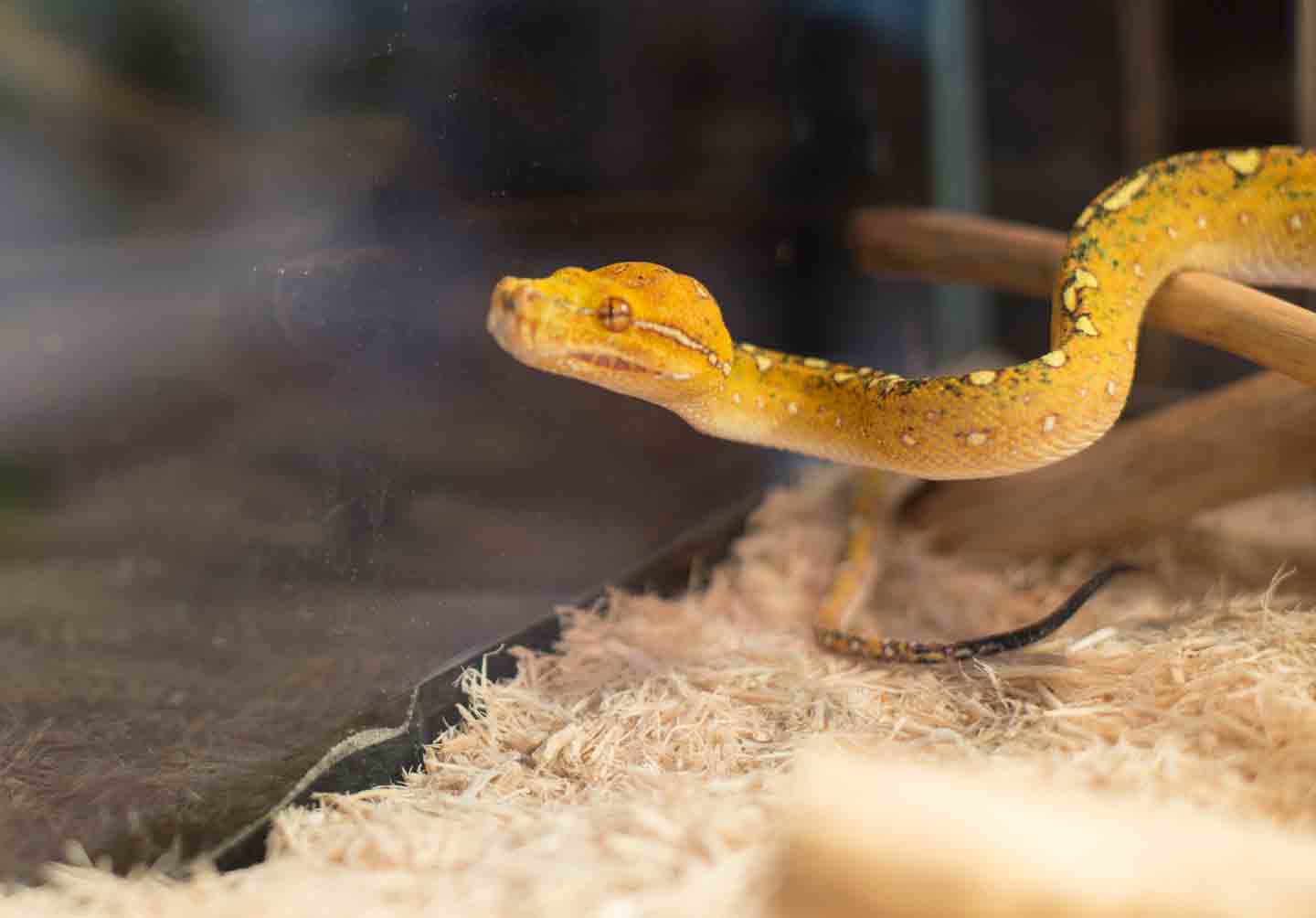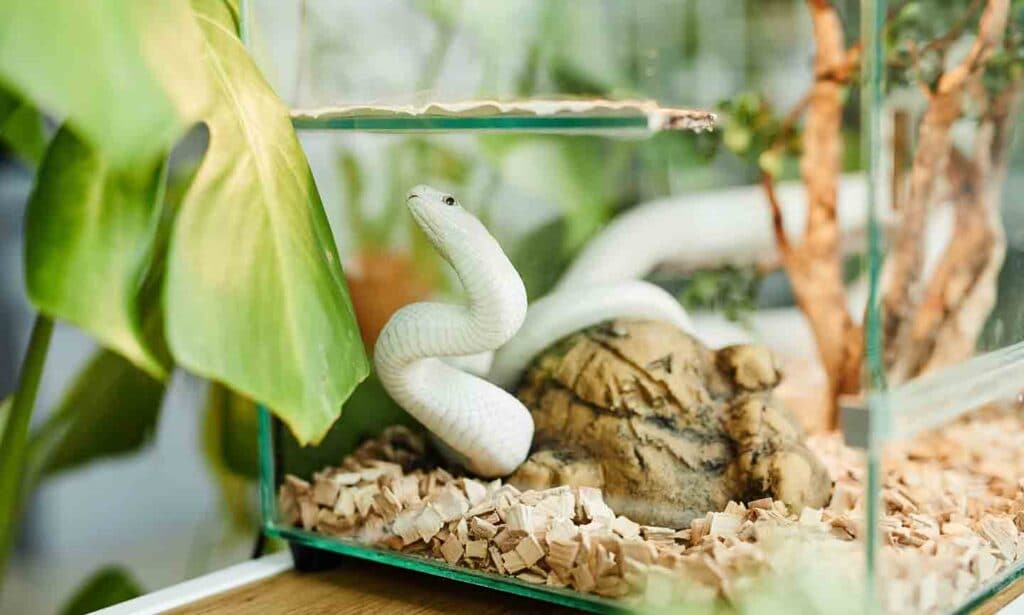When planning to bring a snake home, you first need to set up a secure enclosure that will keep them safe and give them everything they need. In general, snake housing includes substrate, decor, water, heating, and lighting, and it’s an important part of snake care. However, each species of snake is different, so it’s important to research exactly what your specific type of snake needs and discuss with your veterinarian.
With that in mind, follow this guide to setting up an enclosure that will help your new snake thrive and keep them happy.
In This Guide:
Snake Housing Supply Checklist
Enclosure
Your snake’s cage should be secure and easy to clean. It should also be comfortable and spacious enough for them to feel at ease, as it’s where they’ll spend their time when they aren’t being handled.
Size
“There is no such thing as too much space for a snake,” says Catherine Love, DVM, who works at Arbor View Animal Hospital in Valparaiso, Indiana. “They are wild animals that would not have any walls or barriers in nature.”
The bigger concern is making sure your snake enclosure is big enough. Select a cage that’s large enough for your snake to fully stretch out, at a minimum. For example, a 4-foot snake’s enclosure should be at least 4 feet long. To ensure you won’t need to buy a bigger enclosure as your snake grows, research the species (e.g., milk snake, rat snake, ball python) to see how big they’ll be when fully grown.
It is important to take the width and height of the cage into consideration, too, particularly for very large species. “A 10-foot snake may be able to stretch out in a 10-foot-long enclosure, but they won’t have a lot of room to maneuver if they only have a width of 1.5 feet to work with,” says Dr. Love. Some experts use this rule: Your tank’s enclosure should be at least half as wide as the overall length of your snake.
In addition to your snake’s size, consider their habits and natural habitat when shopping for the right vivarium or terrarium, as some like to curl up in burrows while others like to climb. “For an arboreal (tree dwelling) species, vertical space is more important than horizontal space,” says Dr. Love.
Materials
Choose a reptile enclosure made of durable and safe materials, such as glass, wood and PVC.
Dr. Love likes PVC because it’s light, easy to clean and maintains humidity well. “Wood is porous and may be difficult to disinfect, and glass enclosures with a screen top are quite heavy and don’t maintain humidity well,” she says.
Design
Sufficient ventilation is crucial for your snake’s tank. Without it, the air inside the enclosure could become stagnant, increasing the risk of your snake developing a respiratory infection.
In addition, because snakes can figure out how to get out of their cage, it’s equally important to find one that locks securely and is escape-proof.
On the upside, snakes are just one of several common pet animals who like to escape their homes from time to time. (Think bearded dragons, crested geckos, amphibians and tarantulas, for a start.) For that reason, many enclosures come with escape-proofing features designed to keep any animal inside it secure.
Don’t just count on a fish tank with a screen top to keep your snake inside. It isn't going to be secure; can make it difficult to maintain the right temperature and humidity level; and may not provide the right amount of space for your snake.
Bedding

Bedding, aka substrate, lines the bottom of your snake’s enclosure to make it comfortable and mimic their wild habitat. Some substrates are safe, while others can pose health hazards, so shop carefully.
“The best substrate depends on the species of snake, and sometimes a mixture is the most appropriate option,” says Dr. Love. “The best way to choose a substrate for a pet snake is to research and understand what kind of environment they naturally live in.” Ask your vet about the best bedding for your pet snake.
For a snake who likes burrows in a desert environment, options include:
- Desert sand
- Soil and sand mixture
For a snake who needs a high amount of humidity, choose a substrate that will help maintain the right humidity level in the enclosure, such as:
- Reptile-safe soil, like Zoo Med® Reptisoil
- Coconut husk or fiber, like Zoo Med® Eco Earth Coconut Fiber
- Cypress mulch
Adding sphagnum moss mixture or a product like Sungrow Leaf Litter on top of the above bedding options can help maintain humidity too.
Substrates To Avoid
Not all substrates are safe for snakes. Dr. Love advises against using the following:
- Cedar and pine, which can cause illness in reptiles
- Gravel, which is abrasive and not very absorbent
- Paper bedding, which doesn’t hold humidity well
- Crushed walnut, calcium sand or calcium carbonate sand, all of which can cause impactions, injury or serious illness
- Potting mixtures, which can contain harmful fertilizers or additives
Decor
Reptile cage decor makes your snake feel right at home because it mirrors what they would find in the wild. It also provides them with enrichment like hiding places, objects to climb and spots for basking.
Like everything else in the enclosure, decor should be chosen based on your snake’s species. “If you have a species that likes to climb, make sure there are plenty of sturdy, elevated climbing structures,” says Dr. Love. “If you have a shy species, they may need even more cover and hiding spots to feel secure in their enclosure.”
Research what your snake’s habitat looks like, and then do your best to recreate it with items like:
- Live or fake plants
- Cork wood
- Rocks
- Branches
- Leaf litter
- Vines
- Caves
Confirm that your decor is safe before adding it to your reptile terrarium. “Ensure that there aren’t any sharp edges that could hurt your snake, and that any new decor is disinfected prior to introduction into your snake’s enclosure,” Dr. Love says. “Baking or boiling may be necessary to disinfect pieces of wood.”
Source of Water
Your snake should have easy access to fresh, clean water at all times. You can provide this with a water dish or bowl that’s designed for snakes.
The bowl should be large enough that your snake can soak in it, and it should be easy for your snake to slither in and out of it.
Choose a water bowl made of sturdy, safe materials so you can rest assured it will remain in place and won’t be hazardous to your pet. “Avoid any porous materials or anything that could have paint or chemicals that may seep into the water,” says Dr. Love.
Source of Heat and Light
Snakes are ectotherms. They can’t regulate their body temperature, and instead rely on their environment to avoid getting too hot or too cold. So, you’ll need to set up a high-quality heat source that will reliably maintain the appropriate temperature based on their needs.
You can use overhead lighting and heating, including a halogen basking bulb that provides infrared waves similar to those from the sun. There are also heat mats or heating pads that can be applied to the bottom or side of your snake’s tank.
Different snakes have different requirements when it comes to daytime and nighttime temperatures, so again, research your snake’s species to be sure you create the optimal environment.
Snakes require a temperature gradient, aka access to a range of temperatures, so place the heat lamp on one side of the enclosure so you can maintain a cooler side as well.
What To Avoid
Dr. Love says snakes don’t need a red or purple night lamp, which could disrupt their natural circadian rhythm. If you need to provide more heat at night, use a source that doesn’t emit light, such as a ceramic heat emitter.
Also, heat rocks can burn your snake and cause injuries, so they shouldn’t be used.
Humidity and Temperature Regulation
In addition to temperature, the humidity level in your snake’s enclosure should be in the appropriate range for their species.
Controlling temperature and humidity is simple with automatic thermostats and hygrostats. You can also use foggers, sprayers and misters intermittently to increase humidity.
“Just make sure your substrate doesn’t get waterlogged in an attempt to raise the humidity in your tank, as this can cause molding and scale rot,” says Dr. Love.
She also recommends adding a humidity hide to your snake’s cage. Fill one of their snake hides or caves with damp (not sopping wet) moss or substrate to create a humid microclimate that your snake can enter at will.
Use a thermometer to monitor the temperature, and a hygrometer to keep an eye on the humidity.
UVB Light
UVB is a type of light emitted by the sun, and many reptiles need it to synthesize vitamin D, which is used for metabolizing calcium.
“Since snakes eat whole prey with bones full of vitamins and minerals, they get what they need in their diet and don’t technically need supplemental UVB to live,” Dr. Love says, adding that UV light seems to be beneficial for all reptiles and appears to have numerous health benefits, including improved immune function and an increase in natural behaviors.
Choose a UVB light tailored to your type of snake. Dr. Love recommends low levels of UVB for snakes, and says T5 lights are the most efficient way to provide artificial UVB.
Placing and Monitoring UVB Bulbs
As with so many other aspects of your snake’s enclosure, when it comes to where to place the UVB light, it’s based on the species.
“Each species has guidelines for how far from the basking site their UV should be, and what the output should be,” Dr. Love says. In general, snakes require lower levels of UV, so look for lights designed for shade-dwelling or crepuscular (active at dawn and dusk) animals.
Change the bulb often—typically every six months—as it will continue providing light even when it’s no longer giving off adequate UVB. You can use a Solarmeter® to see if your bulb is still working or needs to be replaced.
FAQs About Snake Housing
Q:Can I let my pet snake outside?
A:Snakes can benefit from safe, supervised access to the outdoors and natural sunlight. When you aren’t handling them, keep your snake in a secure enclosure to prevent them from escaping, or getting hurt or sick.
Q:Where should I keep a snake enclosure?
A:It’s best to keep snakes in a quiet area of your home, and away from drafts, small children and other pets, including other reptiles.
Once your snake enclosure is set up, introduce your snake to it. With all of their needs met, they’ll be able to explore their environment and settle in. Meanwhile, you’ll be on to the next step on your snake keeping journey: Learning how and what to feed your snake.
Expert input provided by Catherine Love, DVM, of Arbor View Animal Hospital in Valparaiso, Indiana.
This content was medically reviewed by Chewy vets.
More About Snakes
Share:



























